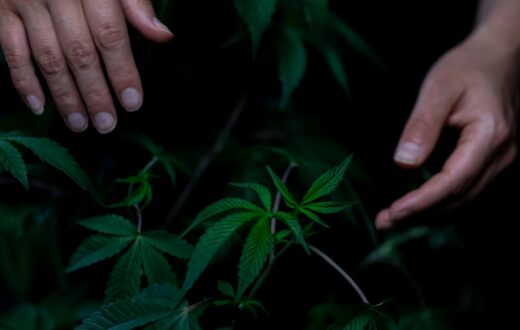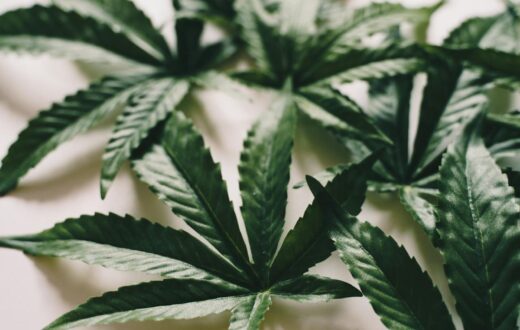Introduction to Alien Rock Candy
Alien Rock Candy is a profoundly intriguing cannabis strain renowned for its unique characteristics and delightful flavor profile. This hybrid strain is a cross between the celebrated strains Alien Kush and Taffy, which bestow upon it both an enjoyable high and a complex array of flavors. The combination of these parental strains contributes significantly to Alien Rock Candy’s appeal, making it a popular choice for both novice and experienced cannabis cultivators.
The effects of Alien Rock Candy are characterized by a well-balanced experience that caters to a wide array of users. Upon consumption, users often report a pleasant euphoria that uplifts the mood while simultaneously resting the body. This cleansing body buzz is paired with a gentle cerebral stimulation, promoting creativity and sociability, perfect for social settings or artistic endeavors. This makes Alien Rock Candy a favorable choice for medicinal users seeking relief from stress, anxiety, or chronic pain, as it can alleviate symptoms while not overwhelming the user.
The strain’s flavor profile is equally captivating, featuring a sweet and fruity taste with hints of sweet citrus and a nostalgic candy-like sweetness that is reminiscent of its namesake. This combination of flavors not only enhances the overall smoking experience but also sets it apart from other strains on the market. Its aroma is equally pleasant, bearing sweet, sugary notes with underlying earthy undertones that add depth to its profile. As a result, this strain appeals to a wide audience, from casual smokers to connoisseurs seeking something special in their cannabis experience.
Understanding the Growth Characteristics
The Alien Rock Candy weed strain is renowned for its distinct growth features that every cultivator should familiarize themselves with before beginning the cultivation process. This hybrid strain typically reaches a height of approximately three to four feet indoors, while outdoor plants can grow significantly taller, sometimes exceeding five feet. The height of this strain is essential for growers to consider, as it influences the spacing between plants and the overall indoor or outdoor garden layout.
Yield potential is another critical characteristic of Alien Rock Candy. Under the right conditions, indoor growers can expect yields ranging from 400 to 600 grams per square meter. Outdoor cultivation tends to produce even higher yields, often exceeding 700 grams per plant. The strain thrives in optimal environments, making it crucial for growers to establish the right growth conditions to maximize production. Growers should ensure that their plants receive adequate light, nutrients, and moisture to achieve these impressive yield figures.
Flowering time is an integral aspect of the growth cycle for Alien Rock Candy. This strain typically flowers within 8 to 10 weeks, making it a relatively moderate to fast option for growers seeking quicker turnaround times. Ideal growing conditions include a controlled indoor environment with a temperature range between 70 to 80 degrees Fahrenheit and humidity levels around 40% to 50%. Outdoors, this strain flourishes best in temperate climates, where sunlight and air circulation are abundant. By understanding these characteristics, growers can effectively prepare for how to grow Alien Rock Candy weed strain, ensuring both success and quality in their cultivation efforts.
Choosing the Right Growing Environment
When it comes to growing the Alien Rock Candy weed strain, selecting the optimal growing environment is crucial to achieving a healthy and robust crop. This particular strain can thrive in both indoor and outdoor settings, but each environment has its own advantages and challenges.
For indoor cultivation, one of the primary benefits is the ability to control environmental factors such as temperature, humidity, and lighting. Alien Rock Candy prefers temperatures between 70°F to 80°F during the day and slightly cooler at night. Maintaining this temperature range is essential for encouraging strong growth and maximizing yield. Furthermore, humidity levels should ideally be kept between 40% and 60% during the vegetative phase, transitioning to lower levels as the plants approach flowering. Adequate ventilation is also necessary to prevent mold and mildew, which can be detrimental to the plants during their growth cycle.
On the other hand, outdoor growing allows the Alien Rock Candy strain to benefit from natural sunlight and fresh air. However, careful consideration of the local climate is important. The ideal outdoor conditions for Alien Rock Candy generally include a mild climate with ample sunshine, free of harsh winds and extreme temperatures. Before planting, it is advisable to prepare the soil by ensuring it is rich in nutrients and has good drainage to accommodate the plant’s growth needs.
Regardless of whether you choose to cultivate indoors or outdoors, creating an optimal growing environment is critical for the success of the Alien Rock Candy weed strain. Utilizing grow tents or greenhouses can particularly enhance indoor setup and provide a controlled environment that mitigates the risks associated with unpredictable weather conditions. In conclusion, by carefully selecting and managing the right growing environment, you can significantly improve your chances of cultivating a successful Alien Rock Candy crop.
Soil and Nutrients for Optimal Growth
The cultivation of the Alien Rock Candy weed strain thrives primarily on the selection of the right soil and nutrients. An ideal growing medium for this strain should be well-aerated, allowing for excellent drainage while retaining sufficient moisture. A combination of 40% peat moss, 40% compost, and 20% perlite is a recommended mix. This blend provides a rich source of organic matter while ensuring proper drainage, which is crucial for the health of the roots.
When focusing on organic options, the importance of using amendments such as worm castings and bat guano cannot be understated. These organic additives enrich the soil with essential nutrients, promoting robust plant growth. For those seeking to improve the nitrogen, phosphorus, and potassium (NPK) levels, incorporating fish emulsion during the vegetative stage can give your plants the necessary boost they require. It’s vital to monitor the nutrient levels and pH to avoid potential nutrient burn, a common issue among growers. A pH level of between 6.0 to 7.0 is generally ideal for maintaining nutrient availability.
A nutrient schedule for the Alien Rock Candy weed strain typically involves a feeding regimen that varies with its growth phases. During the vegetative phase, it is advisable to provide a higher nitrogen content, while the flowering phase necessitates an increased proportion of phosphorus and potassium. For optimal results, consider using a balanced liquid fertilizer that is organic-based and adheres to the feeding requirements of the plant. Regularly assess the plants’ response to fertilization, adjusting as necessary to ensure that they do not exhibit signs of over-fertilization or nutrient deficiencies.
Watering Techniques and Schedules
Successful cultivation of the Alien Rock Candy weed strain greatly depends on proper watering techniques and schedules. Watering not only sustains the plants but also plays a critical role in nutrient uptake and overall health. Understanding the right frequency and quantity of water is essential to avoid common pitfalls such as over or under-watering, both of which can adversely affect the growth and yield of this particular strain.
The general rule of thumb for watering plants is to allow the top inch of soil to dry out before rewatering. For Alien Rock Candy, it is recommended to check the soil moisture regularly, ideally using a moisture meter or by sticking your finger into the soil. This practice helps in assessing the moisture level accurately, thus preventing excessive watering, which can lead to root rot and other issues.
In terms of watering frequency, growers often find that once every few days is sufficient during the vegetative stage, particularly in controlled indoor environments. However, during flowering, plants may require more frequent watering due to their heightened nutrient demands and increased evapotranspiration rates. It is crucial to monitor environmental factors such as humidity, temperature, and light intensity, as these conditions can affect the water needs of the plants.
When it comes to the quantity of water, the goal is to saturate the root zone without allowing water to pool at the bottom of the pot. For container-grown plants, this often means watering until there is a small amount of runoff. Employing these detailed watering techniques and schedules will ensure healthy growth and maximized yield when cultivating the Alien Rock Candy weed strain, allowing you to achieve the best results from your efforts.
Training Techniques for Higher Yields
To cultivate the Alien Rock Candy weed strain successfully, employing various training techniques can significantly enhance yields and promote optimal growth. These methods allow for better light exposure and airflow, which are essential for the health of the plants. Among the most effective techniques are topping, low stress training (LST), and defoliation.
Topping involves cutting off the top of the main stem at a certain height, which encourages the plant to grow multiple colas instead of a single main bud. This method is particularly beneficial for the Alien Rock Candy strain, as it encourages bushy growth and leads to a higher overall yield. When executed correctly, topping can also create a more even canopy, allowing all parts of the plant to receive sufficient light, which is vital for the flowering stage.
Low stress training (LST) is another effective strategy to consider when growing Alien Rock Candy. This technique involves gently bending and tying down the branches to create a more horizontal growth pattern. LST not only maximizes light exposure to lower branches but also helps prevent the plants from becoming too tall and unmanageable. By strategically positioning the branches, growers can achieve a more uniform light distribution, aiding in larger bud development.
Defoliation is the selective removal of leaves to increase airflow and light penetration to the inner parts of the plant. This practice is crucial during the flowering phase for Alien Rock Candy, as it allows for better access to light for the developing buds. However, it’s important to approach defoliation with care, as excessive leaf removal can stress the plant and reduce yield. Implementing these training techniques effectively can lead to a robust harvest, allowing growers to maximize the potential of the Alien Rock Candy weed strain.
Pest and Disease Management
When cultivating the Alien Rock Candy weed strain, understanding pest and disease management is essential to ensure a healthy and productive yield. This particular strain can be susceptible to various pests and diseases, which can significantly impact plant growth and cannabinoid production if not adequately addressed. Common pests include aphids, spider mites, and whiteflies, which thrive in warm and humid conditions. These pests can damage the foliage, leading to decreased vitality and yield. Moreover, diseases such as powdery mildew and root rot can arise, especially in environments with poor air circulation or excessive moisture.
To prevent pest infestations, proactive strategies should be employed. One effective method is to regularly monitor plants for early signs of pests or disease. Utilizing companion planting can also bolster defenses; planting marigolds or basil near Alien Rock Candy plants can naturally deter harmful insects. Additionally, maintaining optimal growing conditions, such as balanced humidity and temperature levels, contributes to stronger plants less susceptible to pests. Ensuring adequate air circulation in the growing environment is crucial to mitigate the risk of fungal diseases.
If pests do invade, organic solutions such as neem oil, insecticidal soap, or diatomaceous earth can be effective in managing these threats. These treatments are less harmful to the environment and ensure that the quality of the weed strain is preserved. In cases of fungal diseases, applying a mixture of water and baking soda can serve as a preventive measure or treatment. For those cultivating Alien Rock Candy, employing these management strategies will not only protect their plants but also enhance the overall health and productivity of their cannabis crop. Understanding how to grow Alien Rock Candy weed strain with an emphasis on pest and disease management is key to a successful harvest.
Harvesting and Curing Your Alien Rock Candy
Harvesting the Alien Rock Candy weed strain at the optimal time is critical for attaining the best flavor and potency. Generally, growers should monitor the trichomes closely, assessing their maturity. These tiny resinous glands transition from clear to a milky white color and eventually, to an amber hue. A good rule of thumb is to initiate the harvest when 70% of the trichomes are milky white and 30% are amber. This timing ensures a balanced psychoactive effect, essential for enjoying the unique qualities of Alien Rock Candy.
Once you have determined the right moment for harvesting, the next step involves using proper techniques to cut and trim the plants. Start by preparing your workspace by ensuring that it is clean and sanitized to avoid contamination. Using sharp, sterilized scissors or pruning shears will help to prevent damaging the buds during cutting. Cut the plant at its base and then hang it upside down in a cool, dark, and well-ventilated environment. This method aids in retaining flavor while preventing mold growth during the drying stage.
After approximately 7 to 14 days, or when the stems snap easily, it’s time to begin the curing process. Curing is crucial for enhancing the flavors and aroma of the Alien Rock Candy strain. Trim the buds away from the stems and place them in airtight glass jars, filling them to about 75% capacity to allow for air exchange. In the first week, open the jars daily for about 15-20 minutes to allow moisture to escape and fresh air to enter. This step reduces any harshness in smoke and maximizes the strain’s unique flavor profile. After the initial week, it is advisable to continue this process every few days for about a month or longer, which will ultimately produce a well-cured product that retains the signature traits of the Alien Rock Candy weed strain.
Troubleshooting Common Growing Issues
Cultivating the Alien Rock Candy weed strain can be a rewarding endeavor, yet growers may encounter various challenges during the growth process. Identifying and addressing these issues promptly is essential to ensure a successful harvest.
One common issue experienced when growing Alien Rock Candy is nutrient deficiency. Signs may include yellowing leaves or stunted growth, which often indicate a lack of essential nutrients. To mitigate this, regularly check the pH levels of your soil or hydroponic system, as imbalances can hinder nutrient absorption. A comprehensive feeding regimen that satisfies the specific needs of Alien Rock Candy is crucial. Consider using a balanced fertilizer that caters to both the vegetative and flowering stages of growth.
Environmental stress is another factor that can impact the health of your plants. The Alien Rock Candy strain thrives in a controlled environment, with optimal temperatures ranging from 70°F to 80°F during the day and slightly cooler at night. If significant fluctuations occur, plants may exhibit symptoms such as leaf curl or discoloration. To avoid this, invest in a reliable thermometer and humidity sensor, making necessary adjustments to your grow room conditions, like using fans for ventilation or heaters to stabilize temperature.
Unexpected growth patterns, such as excessive stretching or uneven canopy development, can also disrupt the cultivation of Alien Rock Candy. These issues typically arise from insufficient light or incorrect training techniques. Regularly inspect light placement; ensure that your plants receive adequate intensity and distance from the light source. Employing training methods such as topping or low-stress training can promote a more uniform growth pattern, allowing for better light penetration and ultimately leading to denser buds.
By being aware of these potential challenges and implementing appropriate solutions, growers can navigate the complexities of how to grow Alien Rock Candy weed strain effectively, enhancing the overall health and yield of their plants.













